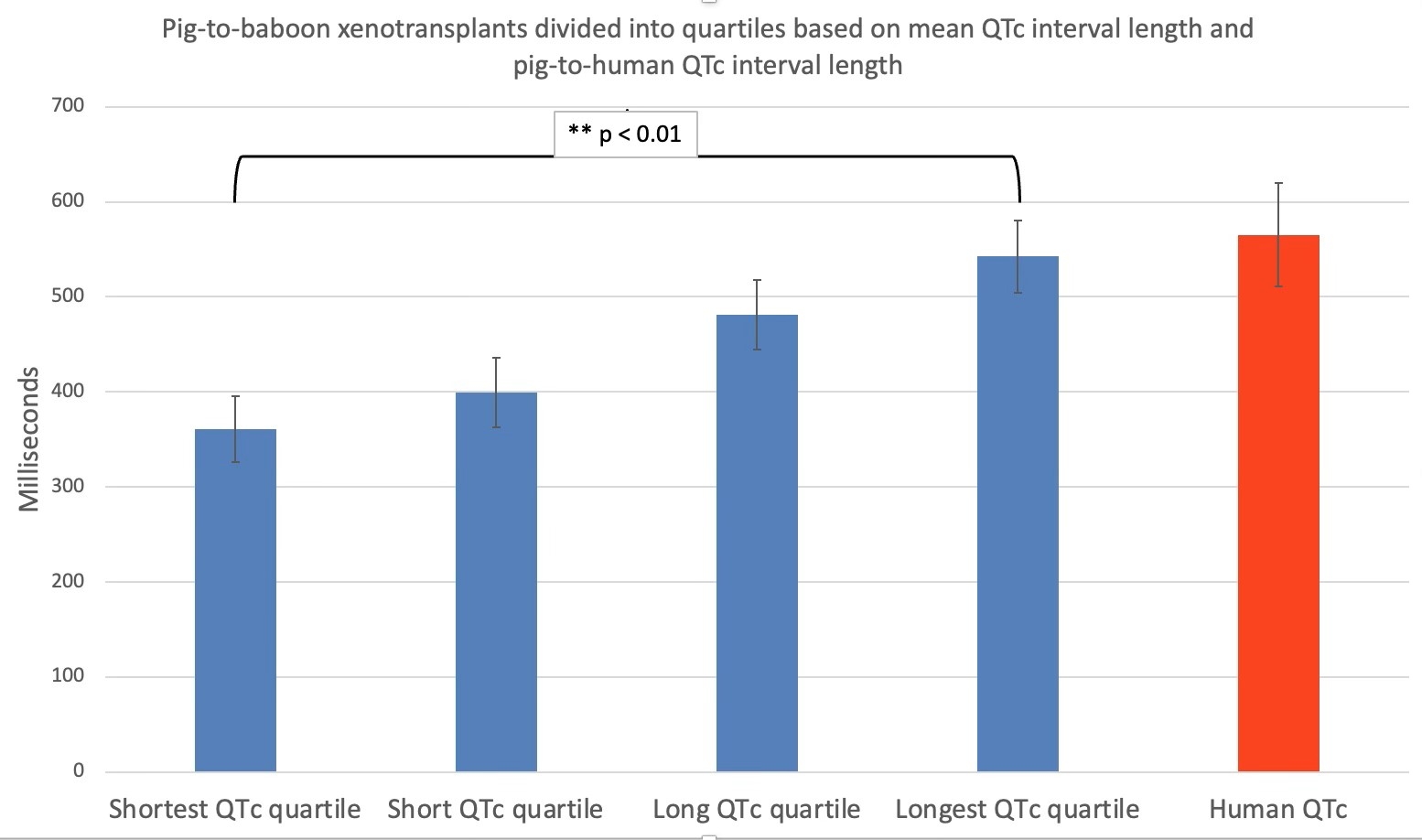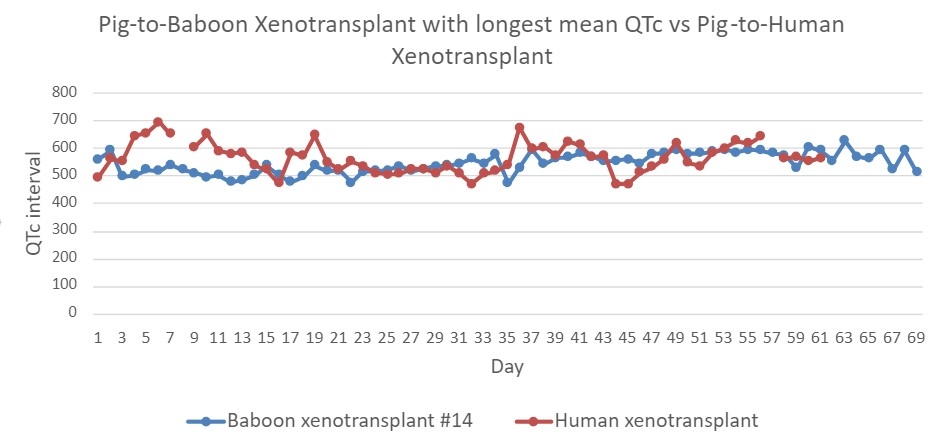Final ID: MDP1261
Variability of Ventricular Repolarization: Lessons Learned from Comparing Animal Xenotransplantations and First Human Genetically Modified Cardiac Xenotransplantation
Abstract Body (Do not enter title and authors here): Background: The worldwide first genetically modified porcine-to-human cardiac xenotransplant (xeno) in 2022 showed a markedly prolonged ventricular repolarization during the 60-day survival raising concerns for ventricular arrhythmias. Longitudinal QTc intervals in 16 porcine-to-baboon cardiac xenos performed at the University of Maryland from 2017-2022 were compared to the human measurements.
Aim: Compare the variability in repolarization between human and simian recipients of genetically modified porcine xenos.
Methods: Daily 12-lead ECGs of the human recipient were compared with long-term recordings of implanted monitors in the baboons.
Results: The first human xenotransplant patient showed longer repolarization compared to the cohort of 16 baboons with porcine xenos (QTc 570±58ms [range 438-698ms] vs QTc 432±89ms [range 288-627ms]; p<0.01). When dividing 16 baboons into 4 groups from shortest to longest mean QTc intervals (361±34ms vs 399±37ms vs 481±36ms vs 542±38ms; p<0.01 for shortest vs longest QTc quartile), no group approached the mean QTc of the human (p<0.01). However, when compared to the baboon with the longest QTc and similar survival (69 vs 60 days), the QTc intervals were closer approximated (547±37ms [range 474-627ms]; p=0.03) and did not significantly differ after the initial 20 post-operative days (human 551±52ms vs baboon 559±33ms, p=0.38).
Conclusion: While the first human xeno showed prolonged repolarization, the baboon cohort demonstrated significant variability of repolarization duration. QTc prolongation of similar magnitude was observed in the baboon with longest repolarization with comparable follow up. Therefore, the prolonged QTc in the single human xeno may either represent the different physiological response in human environment or an outlier similar to the baboon with the longest QTc. A larger human cohort will help answer this question and further assess the potential arrhythmic risk of xenotransplantation.
Aim: Compare the variability in repolarization between human and simian recipients of genetically modified porcine xenos.
Methods: Daily 12-lead ECGs of the human recipient were compared with long-term recordings of implanted monitors in the baboons.
Results: The first human xenotransplant patient showed longer repolarization compared to the cohort of 16 baboons with porcine xenos (QTc 570±58ms [range 438-698ms] vs QTc 432±89ms [range 288-627ms]; p<0.01). When dividing 16 baboons into 4 groups from shortest to longest mean QTc intervals (361±34ms vs 399±37ms vs 481±36ms vs 542±38ms; p<0.01 for shortest vs longest QTc quartile), no group approached the mean QTc of the human (p<0.01). However, when compared to the baboon with the longest QTc and similar survival (69 vs 60 days), the QTc intervals were closer approximated (547±37ms [range 474-627ms]; p=0.03) and did not significantly differ after the initial 20 post-operative days (human 551±52ms vs baboon 559±33ms, p=0.38).
Conclusion: While the first human xeno showed prolonged repolarization, the baboon cohort demonstrated significant variability of repolarization duration. QTc prolongation of similar magnitude was observed in the baboon with longest repolarization with comparable follow up. Therefore, the prolonged QTc in the single human xeno may either represent the different physiological response in human environment or an outlier similar to the baboon with the longest QTc. A larger human cohort will help answer this question and further assess the potential arrhythmic risk of xenotransplantation.
More abstracts on this topic:
Assessing Racial Disparities in Heart Transplant Allocations Post-2018 Policy Change
Malkani Kabir, Zhang Ruina, Li Han, Ezema Ashley, Steitieh Diala, Purkayastha Subhanik, Kini Vinay
Acacetin's Antiarrhythmic Potential in Human-Induced Pluripotent Stem Cell-Derived Cardiomyocytes Harboring Hypertrophic and Dilated Cardiomyopathy-Related MutationsAbdelsayed Mena, Mercola Mark, Antzelevitch Charles


